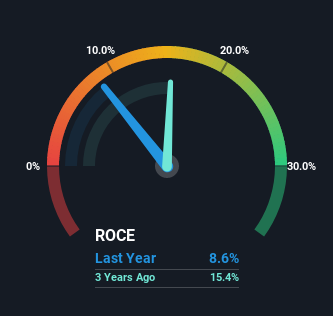- Israel
- /
- Construction
- /
- TASE:BRND
Brand Group (M.G) (TLV:BRND) Shareholders Will Want The ROCE Trajectory To Continue

To find a multi-bagger stock, what are the underlying trends we should look for in a business? Ideally, a business will show two trends; firstly a growing return on capital employed (ROCE) and secondly, an increasing amount of capital employed. Ultimately, this demonstrates that it's a business that is reinvesting profits at increasing rates of return. Speaking of which, we noticed some great changes in Brand Group (M.G)'s (TLV:BRND) returns on capital, so let's have a look.
Return On Capital Employed (ROCE): What Is It?
For those who don't know, ROCE is a measure of a company's yearly pre-tax profit (its return), relative to the capital employed in the business. The formula for this calculation on Brand Group (M.G) is:
Return on Capital Employed = Earnings Before Interest and Tax (EBIT) ÷ (Total Assets - Current Liabilities)
0.086 = ₪14m ÷ (₪311m - ₪150m) (Based on the trailing twelve months to September 2022).
Therefore, Brand Group (M.G) has an ROCE of 8.6%. On its own that's a low return, but compared to the average of 6.8% generated by the Construction industry, it's much better.
See our latest analysis for Brand Group (M.G)

While the past is not representative of the future, it can be helpful to know how a company has performed historically, which is why we have this chart above. If you're interested in investigating Brand Group (M.G)'s past further, check out this free graph of past earnings, revenue and cash flow.
What Does the ROCE Trend For Brand Group (M.G) Tell Us?
We're glad to see that ROCE is heading in the right direction, even if it is still low at the moment. Over the last five years, returns on capital employed have risen substantially to 8.6%. Basically the business is earning more per dollar of capital invested and in addition to that, 30% more capital is being employed now too. So we're very much inspired by what we're seeing at Brand Group (M.G) thanks to its ability to profitably reinvest capital.
Another thing to note, Brand Group (M.G) has a high ratio of current liabilities to total assets of 48%. This can bring about some risks because the company is basically operating with a rather large reliance on its suppliers or other sorts of short-term creditors. While it's not necessarily a bad thing, it can be beneficial if this ratio is lower.
The Key Takeaway
A company that is growing its returns on capital and can consistently reinvest in itself is a highly sought after trait, and that's what Brand Group (M.G) has. And since the stock has dived 74% over the last five years, there may be other factors affecting the company's prospects. Still, it's worth doing some further research to see if the trends will continue into the future.
One final note, you should learn about the 2 warning signs we've spotted with Brand Group (M.G) (including 1 which is concerning) .
If you want to search for solid companies with great earnings, check out this free list of companies with good balance sheets and impressive returns on equity.
Valuation is complex, but we're here to simplify it.
Discover if Brand Group (M.G) might be undervalued or overvalued with our detailed analysis, featuring fair value estimates, potential risks, dividends, insider trades, and its financial condition.
Access Free AnalysisHave feedback on this article? Concerned about the content? Get in touch with us directly. Alternatively, email editorial-team (at) simplywallst.com.
This article by Simply Wall St is general in nature. We provide commentary based on historical data and analyst forecasts only using an unbiased methodology and our articles are not intended to be financial advice. It does not constitute a recommendation to buy or sell any stock, and does not take account of your objectives, or your financial situation. We aim to bring you long-term focused analysis driven by fundamental data. Note that our analysis may not factor in the latest price-sensitive company announcements or qualitative material. Simply Wall St has no position in any stocks mentioned.
About TASE:BRND
Brand Group (M.G)
Engages in metal construction and infrastructure, energy facilities, petrochemical facilities, and other industrial facilities in Israel.
Low with questionable track record.
Market Insights
Community Narratives



